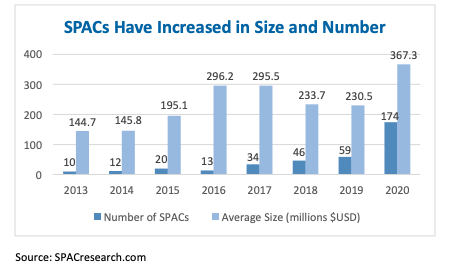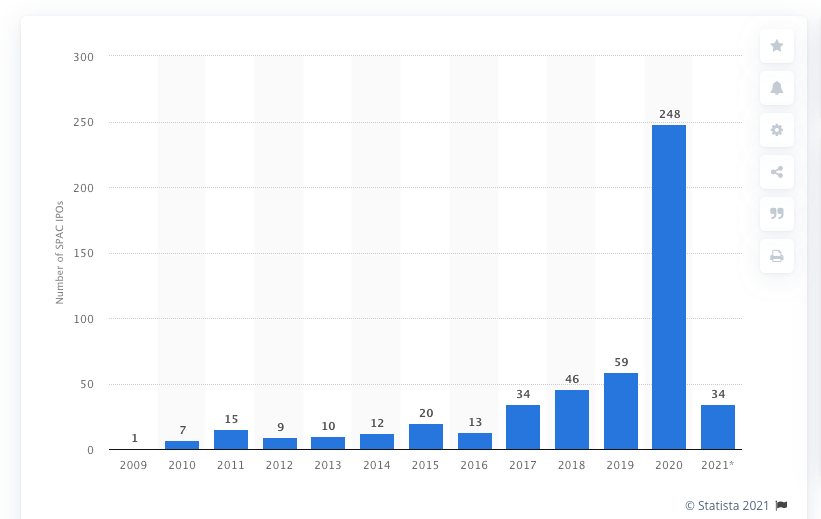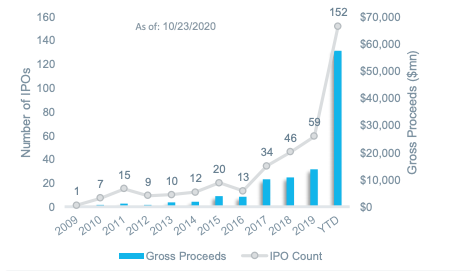How SPAC Investment work
Investing in SPACs before they announce their acquisition target can lead to triple-digit returns in a matter of weeks. See how SPAC investment work
What is a SPAC?
Some in the industry will refer to them as "Blank check companies" or "Shell companies". But better terms would be "Private equity investment company". They are publicly traded buy have no business operations of any kind.
The sponsors of a SPAC tend to put up 3–5% of the capital required to form the company. We can think of the sponsors of the SPAC as the management team. Its objective is to take the SPAC public, raise funds, and search for a target company to merge with. The money raised in the IPO is held in a trust until a suitable investment target is found.

Once the SPAC management team agrees to invest in a target company, the SPAC and the private company merge. In essence, a private company goes public by “backing into” a SPAC. This is typically referred to as a reverse merger.
Once that happens, the private company raises additional capital when the business combination happens. That’s why investing in a SPAC is a backdoor into an IPO. We’re investing in a publicly traded private equity company that will eventually become a publicly traded real operating company.
The names of most SPACs can be strange. They are just a placeholder until a business combination takes place. The funds raised in a SPAC are held in a trust until a desirable business combination is found.

Learn by example
For Eg, Social Capital Hedosophia Holdings, IPOA, filled to sell 57,500,000 units at $10 a unit. This would raise $575,000,000. Please note that they are not shares, but Units.
One unit is composed of one share of the publicly traded company and one-third of a warrant. Warrant portion can be different for different SPACs. After the SPAC goes public, typically within 52 days after the IPO, the units splits.
Basically Two Securities for the price of One
The warrant coverage is a very unique aspect of investing in SPACs. A warrant is the right to acquire one share of stock at a specific price. A warrant is similar to an option in that it has a strike price. It also has an expiration date. However, the expiration is usually five to seven years in the future. We will sell the warrants long before then. So unlike most options, we won’t suffer any time decay. In that sense, warrants are far more valuable.
In October 2019, Palihapitiya announced an exciting merger with Virgin Galactic Holdings. After a while once merger confirmed it changed symbol from IPOA to SPCE. The stock rocketed 260% and rise in the warrants was even more spectacular. At their peak, IPOA.U warrants rose 1,371%.
Here’s what that would mean for an investor in IPOA.U. Investors who acquired 300 units of IPOA.U at a cost of $3,000 (300 x $10/unit) would have received 100 warrants in IPOA.U. If they sold their shares mid-February, their profit on the shares would have been around $8,200. A fantastic return on all accounts.
Yet the returns on the warrants would have been extraordinary at 1,371%, resulting in an additional profit of $2,194. In total, a $3,000 investment in IPOA.U would have resulted in more than a $10,000 profit.
If a suitable investment target is not found, the original investment, which is held in a trust, is returned to all investors. That’s right. Investors get their money back if the sponsors don’t make a deal.
We will play SPAC in two ways
- Purchase units in a SPAC, claim our warrants after the split, and sell the shares in the SPAC to recoup our initial investment. This is conservative.
- Purchase units in a SPAC, claim our warrants, then hold on to both for the upside potential once a business combination is announced. More speculative but more rewarding.
Here's How We Are Going To Profit
- We’ll buy the units in SPACs with compelling investment potential before the stock and warrants split into their component parts.
- Sometimes, we’ll sell the stock and hold the warrants for future upside or just book the profits after announcement rally and buyback later on weakness.
- Sometimes, we’ll buy more warrants at attractive pricing to increase our profit potential.
- Sometimes, we’ll sell warrants that have run up in price to capture quick profits and hold the underlying stock.
- We’re going to invest in SPACs with strong sponsors who are executives with strong track records in their fields.
- We’re also going to focus on the sectors that have consistently delivered the best performance amongst SPACs. That means technology, media, telecommunications, health care, financial technology, biotechnology, and occasionally a consumer brand play.
- See our portfolio here, where we plan to invest in 15 SPAC stocks
SPAC Market Activity
SPAC IPO activity has soared past all time highs with the number of IPOs year-to-date at nearly 3x the 2019 total and proceeds year-to-date are greater than the aggregate from the last decade.

IPOs have been raising record proceeds with an average of nearly $370 million per SPAC IPO and some raises into the billions of dollars.
44% of the SPACs that have gone public or announced IPO since the beginning of 2017 are actively seeking targets. 26% have completed the merger, 14% is pending and 16% are pre-IPO.
While many SPACs do not advertise a specific industry for an intended target. Tech, media and telecommunication is the most targeted industry.
SPAC Portfolio
